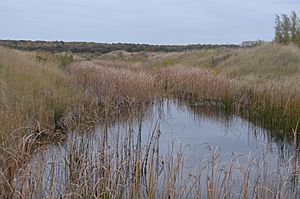Orton Pit facts for kids
| Site of Special Scientific Interest | |
 |
|
| Area of Search | Cambridgeshire |
|---|---|
| Interest | Biological |
| Area | 145.8 hectares |
| Notification | 2004 |
| Location map | Magic Map |
Orton Pit is a very special place for nature near Peterborough in Cambridgeshire, England. It covers a large area of 145.8 hectares, which is about 360 acres. This site is protected because it's home to many rare and important plants and animals.
It is known as a Site of Special Scientific Interest (SSSI). This means the government has recognized it as one of the best places in the country for wildlife. Orton Pit is also a Special Area of Conservation, which is an even higher level of protection across Europe.
Contents
Why is Orton Pit So Important?
Orton Pit used to be a place where clay was dug out to make bricks. Now, these old clay pits have filled with water and created amazing habitats for wildlife. This makes it a unique and important area.
Home to Rare Animals
Orton Pit is famous for having the largest group of great crested newts in all of Britain. These newts are amphibians, like frogs, but they have rough skin and a jagged crest on their backs during breeding season. They need clean ponds to lay their eggs.
Amazing Plants and Habitats
The site is also home to many rare plants. You can find ten different types of stonewort here. Stoneworts are a type of algae that look like small plants and grow in clear water. One very special type, called chara canescens, was once thought to be completely gone from Britain. But it was found thriving at Orton Pit! There are also four other types of stonewort that are rare across the country.
The area has different kinds of habitats, which means many different places for animals and plants to live. These include:
- Ponds: Perfect for newts and stoneworts.
- Scrubland: Areas with small trees and bushes.
- Rough grassland: Open grassy areas.
This mix of habitats helps many different species survive and grow.
Visiting Orton Pit
Orton Pit is mostly private land. This means that most of the area is not open to the public. This helps to protect the sensitive wildlife that lives there.
However, there is a small part of the site that you can visit. This is a small wood located in the north-east corner. You can find it north of Guelder Road and Ewood Drive. This small section allows people to enjoy a little piece of this important natural area.

